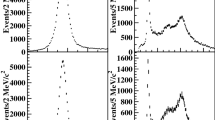Abstract.
Recent evidence for pentaquark baryons in the channels \(\Xi^-\pi^-\), \(\Xi^-\pi^ + \) and their anti-particles claimed by the NA49 collaboration is critically confronted with the vast amount of existing data on \(\Xi\) spectroscopy which was accumulated over the past decades. It is shown that the claim is inconsistent with these data. In addition two further exotic channels of the pentaquark type available in the NA49 data are investigated. It is argued that this study leads to internal inconsistency with the purported signals.
Similar content being viewed by others
References
T. Nakano et al. , Phys. Rev. Lett. 91 012002 (2003)
V.V. Barmin et al. , DIANA Collaboration, Phys. Atom. Nucl. 66 (2003) 1715; Yad. Fiz. 66 1763 (2003)
J. Barth et.al., SAPHIR Collaboration, Phys. Lett. B572 127 (2003)
A.E. Asratyan et al. , hep-ex/0309042, 25 September 2003
V. Kubarovsky et al. , CLAS Collaboration, hep-ex/0311046, 21 November 2003
A. Airapetian et al. , HERMES Collaboration, hep-ex/0312044, 22 January 2004
C. Alt et al. , NA49 Collaboration, Phys. Rev. Lett. 92 042003 (2004)
D. Aston et al. , Phys. Rev. D32 2270 (1985)
M. Baubillier et al. , Nucl. Phys. B192 1 (1981)
S.F. Biagi et al. , Z. Phys. C9 305 (1981)
J.K. Hassall et al. , Nucl. Phys. B189 397 (1981)
P. Sixel et al. , Nucl. Phys. B159 125 (1979)
E. Briefel et al. , Phys. Rev. D16 2706 (1977); E. Briefel et al. , Phys. Rev. D12 1859 (1975)
S.N. Ganguli et al. , Nucl. Phys. B128 408 (1977)
J.B. Gay et.al., Phys. Lett. B62 477 (1976)
A. de Bellefon et.al., Nuov. Cim. 28A 289 (1975)
F.A. Dibianca and R.J. Endorf, Nucl. Phys. B98 137 (1975)
J. Badier et al. , Nucl. Phys. B37 429 (1972); J. Badier et al. , Phys. Lett. 16 171 (1965)
S.R. Borenstein et al. , Phys. Rev. D5 1559 (1972)
R.T. Ross et.al., Phys. Lett. B38 177 (1972)
S. Apsell et al. , Phys. Rev. Lett. 24 777 (1970); S. Apsell et al. , Phys. Rev. Lett. 23 884 (1969)
D.J. Crennell et al. , Phys. Rev. D1 847 (1970)
E.L. Goldwasser and P.F. Schultz, Phys. Rev. D1 1960 (1970)
J. Alitti et al. , Phys. Rev. Lett. 22 79 (1969); J. Alitti et al. , Phys. Rev. Lett. 21 1119 (1968)
J. Bartsch et.al., Phys. Lett. B28 439 (1969); J. Bartsch et.al., Nucl. Phys. B4 326 (1968)
P.M. Dauber et al. , Phys. Rev. 179 1262 (1969)
D.G. Scotter et.al., Nuov. Cim. 62A 1057 (1969)
G.S. Abrams et al. , Phys. Rev. 175 1697 (1968)
G.A. Smith et al. , Phys. Rev. Lett. 14 25 (1965); G.A. Smith et al. , Phys. Rev. Lett. 13 61 (1964)
M.I. Adamovich et al. , W89 Collaboration, Eur. Phys. J. C5 621 (1998)
M.I. Adamovich et al. , W89 Collaboration, Eur. Phys. J. C11 271 (1999)
M.I. Adamovich et al. , W89 Collaboration, Eur. Phys. J. C26 357 (2003)
M.I. Adamovich et al. , W89 Collaboration, hep-ex/0405042 (2004); K.T. Knöpfle, M. Zavertyaev, T. Zivko, HERA-B Collaboration, hep-ex/0403020; P. Hansen, ALEPH Collaboration, DIS-2004, Strbské Pleso, Slovakia; http://www.saske.sk/dis04/wgc.html; I. Goralov, CDF Collaboration, DIS-2004, Strbské Pleso, Slovakia; http://www.saske.sk/dis04/wgc.html; S. Chekanov, ZEUS Collaboration, DIS-2004, Strbské Pleso, Slovakia; http://www.saske.sk/dis04/wgc.html; D. Christian, E690 Collaboration, QNP-2004, Bloomington, Indiana; http://www.qnp2004.org/; V. Halyo, BABAR Collaboration, APS-2004, Denver, Colorado; http://www.slac.stanford.edu/BFROOT/
i.e. roughly 10% of the total number of observed \(\Xi^-\) which is about 1600 [7].
V. Cerny et al. , Baryon Spectroscopy and a Search for Pentaquark States with the NA49 Detector, CERN/SPSC 2003-025, SPSC-I-227
H. Walliser and V.B. Kopeliovich, J. Exp. Theor. Phys. 97 433; (2003) Zh. Eksp. Teor. Fiz. 124 483 (2003)
D. Barna, PhD Thesis, KFKI Budapest (2003)
R.H. Dalitz, Proc. Amsterdam International Conference on Elementary Particles 1971, North Holland 1972, p. 201
D. Drijard et.al., Phys. Lett. B81 250 (1979)
M. Basile et.al., Lett. Nuov. Cim. 31 97 (1981); G. Bari et al. , Nuov. Cim. 104A 1987 (1991)
D. Drijard et.al., Phys. Lett. B108 361 (1982)
H.G. Fischer and W.M. Geist, Z. Phys. C19 159 (1983); E.L. Berger and D.E. Soper, Nucl. Phys. B247 29 (1984)
Author information
Authors and Affiliations
Corresponding author
Additional information
Received: 16 January 2004, Published online: 24 August 2004
Correspondence to: S. Wenig
Rights and permissions
About this article
Cite this article
Fischer, H.G., Wenig, S. Are there S = -2 pentaquarks?. Eur. Phys. J. C 37, 133–140 (2004). https://doi.org/10.1140/epjc/s2004-01952-8
Issue Date:
DOI: https://doi.org/10.1140/epjc/s2004-01952-8




